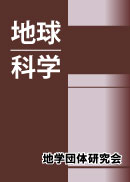All issues

Volume 37 (1983)
- Issue 6 Pages 297-
- Issue 5 Pages 235-
- Issue 4 Pages 187-
- Issue 3 Pages 119-
- Issue 2 Pages 61-
- Issue 1 Pages 1-
Volume 37, Issue 2
Displaying 1-8 of 8 articles from this issue
- |<
- <
- 1
- >
- >|
-
A. KOYAMA, K. TOBITA, T. UCHIYAMA, K. SUGANO, T. CHO, H. TOGASHIArticle type: Article
1983Volume 37Issue 2 Pages ii-iib,iii
Published: March 25, 1983
Released on J-STAGE: July 26, 2017
JOURNAL FREE ACCESSDownload PDF (2294K) -
Atsushi KANEKOArticle type: Article
1983Volume 37Issue 2 Pages 61-68a
Published: March 25, 1983
Released on J-STAGE: July 26, 2017
JOURNAL FREE ACCESS -
RESEARCH GROUP ON THE KATANISHI FORMATIONArticle type: Article
1983Volume 37Issue 2 Pages 69-80
Published: March 25, 1983
Released on J-STAGE: July 26, 2017
JOURNAL FREE ACCESSThe Pleistocene Katanishi Formation is distributed in the Katanishi area of the north-eastern part of the Oga Peninsula. It unconformably overlies the Anden Formation and consists mainly of loose sand and gravel, which are almost horizontal. The type Katanishi Formation is subdivided into four members: the Tarusawa Sand Member, Kakumazaki Mud Member, Matsukizawa Sand and Gravel Member, and Honnai Sand Member (Table 1). The Kakumazaki Mud Member conformably overlies the Tarusawa Sand Member and probably interfmgers with the Matsukizawa Sand and Gravel Member. The Honnai Sand Member, the uppermost member of the formation, covers the Matsukizawa Sand and Gravel Member with conformity. The Kamayachi Formation of HUZIOKA and TAKAYASU (1965) is a fossiliferous sand facies in the basal part of the Matsukizawa Sand and Gravel Member directly overlying the basement rocks, so it is here named the Kamayachi Facies of the Katanishi Formation. The Tarusawa Sand Member yielded cool shallow marine molluscs and the Kakumazaki Mud Member brackish water mollusca Crassostrea sp. The molluscan assemblage of the Kamayachi Facies shows that the Matsukizawa Sand and Gravel Member deposited in a warm, nearshore shallow sea. Pollen analysis (Fig. 6) indicates warm climate during deposition of the Kakumazaki Mud and Honnai Sand Members. The Katanishi Formation is composed mainly of warm, shallow marine and brackish water sediments. Stratigraphy and geographic distribution of the sedimentary facies of the Katanishi Formation indicate a set of off-shore bar and lagoon behind it, which had grown from sand and gravel beach with rise of sea level. The depositional surface of the formation coincides with the Katanishi Terrace Plain 40-60 m above sea level, which represents the the last major high stand of sea level. The Katanishi Formation is a correlative with deposits of the Last Interglaciation.View full abstractDownload PDF (1614K) -
a preliminary reportKotaro KAMADA, Tetsuro SHIOBARAArticle type: Article
1983Volume 37Issue 2 Pages 81-89
Published: March 25, 1983
Released on J-STAGE: July 26, 2017
JOURNAL FREE ACCESSA new experimental apparatus has been devised to initiate deformation within a confined aquifer. Multi-layer sequences have been produced in awater tank by alternate settling of gravel, sand and silt (Fig. 5). A sand layer enclosed between silt layers represents a confined aquifer. The model stratified sequence was shocked by vibration, causing deformation. The experimental results indicate that internal erosion and fragmentation of the silt layer took place in a confined aquifer. During vibration volcano-like eruption often occurred from the culmination of deformed sediment. Such phenomena are explained in terms of fluidization behaviour of confined, water-saturated, unconsolidated sand layers.View full abstractDownload PDF (1577K) -
Tsutomu CHITOKUArticle type: Article
1983Volume 37Issue 2 Pages 90-97
Published: March 25, 1983
Released on J-STAGE: July 26, 2017
JOURNAL FREE ACCESSThe Setana Formation, consists mainly of loose, coarse sand, widely developes in the Southwestern part of Hokkaido. It has long been considered as the representative marine Pliocene stratum in Hokkaido. Two types of calcareous nannofossil assemblages are discriminated in this Setana Formation. One is predominated by Coccolithus pelagicus and the other by Gephyrocapsa spp. Ecological consideration of recent coccolithophorid strongly suggests that the former is indicative of cold-water flora and the latter is temperate. UOZUMI'S suggestion (1962) that the Setana Molluscan Fauna was under the influence of both cold and warm current, is well coincident with the present consideration. Based on the occurrence of calcareous nannofossils as various morphotypes of Gephyrocapsa and P. lacunosa, the Setana Formation is obviously correlatable with the coccolith subzone CN14a (0.9-0.3 Ma) of OKADA and BUKRY (1980). Age of the Setana Formation therefore is Early to Middle Pleistocene.View full abstractDownload PDF (1864K) -
Harumi SOMEKAWA, Shusaku YOSHIKAWAArticle type: Article
1983Volume 37Issue 2 Pages 98-109
Published: March 25, 1983
Released on J-STAGE: July 26, 2017
JOURNAL FREE ACCESSThe detailed tephrostratigraphical study in the Tanabe Hills revealed the following facts. 1) The Plio-Pliestocene Osaka Group in the Tanabe Hills attains more than 200 m thick and is composed of unconsolidated gravel, sand, silt and clay of limnic, fluvial and marine origin. The succession of these sediments is divided into 4 members, namely the Higashibata alternations, Mizudori gravels, Zakuro alternations and Inuidani alternations, in the ascending order. Among more than 12 volcanic ash layers found in these members, 3 are available as key beds. They are named the Higashibata, Fugenji and Zakuro volcanic ash layers (Fig. 2, 3 and 5). 2) On the basis of the tephrostratigraphic and petrographic data of volcanic ash layers, the Higashibata and Zakuro volcanic ash layers can be correlated with the Fukuda and Pink volcanic ash lavers in the southern part of Osaka (Fig. 8).View full abstractDownload PDF (1429K) -
Keiji MATSUOKAArticle type: Article
1983Volume 37Issue 2 Pages 110-113
Published: March 25, 1983
Released on J-STAGE: July 26, 2017
JOURNAL FREE ACCESSDownload PDF (845K) -
Kiyomi SUMIDAArticle type: Article
1983Volume 37Issue 2 Pages 114-116
Published: March 25, 1983
Released on J-STAGE: July 26, 2017
JOURNAL FREE ACCESSDownload PDF (277K)
- |<
- <
- 1
- >
- >|